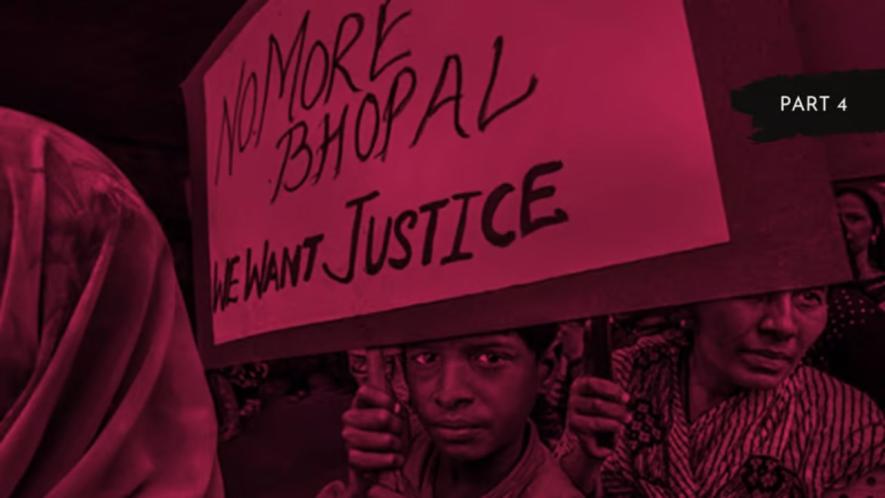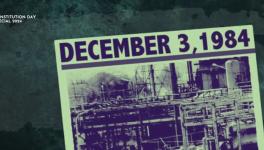Bhopal Gas Tragedy: 40 Years of Struggle for Justice—Part 4

On May 12, 1986, Judge John F. Keenan of the southern district court of New York dismissed the complaint filed by the Union of India against Union Carbide Corporation (UCC) on April 8, 1985.
The Order dismissing the complaint, which has been reproduced in Upendra Baxi (ed.), Inconvenient Forum and Convenient Catastrophe: The Bhopal Case, July 1986, specified the grounds for dismissal as follows:
“This court is firmly convinced that the Indian legal system is in a far better position than the American courts to determine the cause of the tragic event and thereby fix liability. Further, the Indian courts have greater access to all the information needed to arrive at the amount of compensation to be awarded to the victims.
“The presence in India of the overwhelming majority of the witnesses and evidence, both documentary and real, would by itself suggest that India is the most convenient forum for this consolidated case. The additional presence in India of all but the less than handful of claimants underscores the convenience of holding trial in India.” (Paras 2–3, p. 68)
The Union of India is a world power in 1986, and its courts have the proven capacity to mete out fair and equal justice.
The said Order also reposed a lot of faith in the Indian judicial system:
“The Union of India is a world power in 1986, and its courts have the proven capacity to mete out fair and equal justice. To deprive the Indian judiciary of this opportunity to stand tall before the world and to pass judgment on behalf of its own people would be to revive a history of subservience and subjugation from which India has emerged.
“India and its people can and must vindicate their claims before the independent and legitimate judiciary created there since the Independence of 1947.” (Para 2, p. 69)
Therefore, the consolidated case was dismissed on the grounds of forum non conveniens under the following conditions set by Judge Keenan:
“1. Union Carbide shall consent to submit to the jurisdiction of the courts of India and shall continue to waive defenses based upon the statute of limitations;
2. Union Carbide shall agree to satisfy any judgment rendered by an Indian court, and if applicable, upheld by an appellate court in that country, where such judgment and affirmance comport with the minimal requirements of due process:
3. Union Carbide shall be subject to discovery under the model of the United States Federal Rules of Civil Procedure after appropriate demand by plaintiffs.” (Para 5, p.69)
The conditions set by Judge Keenan may appear just and fair on the face of it. However, as Prof. Upendra Baxi has pointed out:
“It is indeed possible that no matter how it is decided, Union Carbide may plead specific configurations of denial of even the 'minimal due process'— a concept inchoate enough to generate a lot of jurisprudence' around it.” (Para 1, p. 32)
India and its people can and must vindicate their claims before the independent and legitimate judiciary created there since the Independence of 1947.
Litigation before Bhopal district court
Following the dismissal of the complaint before the southern district court of New York, Union of India filed a ‘suit for damages’ (Regular civil suit no. 1113 of 1986) before the court of district judge, Bhopal on September 5, 1986.
The same has been reproduced in Upendra Baxi and Amita Dhanda (ed.), Valiant Victims & Lethal Litigation: The Bhopal Case, 1990. On September 8, 1986, the district court issued notice to the UCC and directed it to file a written statement on or before October 6, 1986. [Baxi & Dhanda (1990), p. 13]
The UCC failed to do so, and the district court issued fresh summons on October 7, 1986 and fixed the hearing for October 30, 1986.
Non-destruct Order
Furthermore, on October 7, 1986, the district court, in response to interlocutory application (IA) no. 2 filed by the plaintiff Union of India on October 06, 1986, issued an ex parte ad interim non-destruct Order against the defendant UCC as follows:
“[I]t is ordered, in the larger interest of justice, that the defendant be restrained till further orders from destroying, damaging or mutilating the documents which means and includes for the purpose of this Order every writing and record of every type and description and all preliminary drafts thereof including, amongst others, contracts, policies, agreements, worksheets, correspondence, memoranda, handwritten and typed notes, statements, reports, minutes, recordings videotapes, press releases, newspaper articles, transcripts and summaries of' meetings, voice recordings, pictures, photographs, drawings, computer cards, tapes, discs, printouts and records of all types, studies, books pamphlets, invoices, cancelled cheques and every other device or medium by which or through which information is transmitted, recorded or preserved, and includes a copy where the original is not in the possession, custody or control of Union Carbide Corporation and every copy of any document if such copy is not an identical duplicate of the original.
“Further, a document shall also be deemed relevant whether it came into the possession, custody or control of the defendant subject to this Order prior to December 3, 1984, or after December 3, 1984, such as in the course of the investigation of the incident, in its possession or power by itself including all its members and officers or through its subsidiaries and affiliates, employees and its attorneys and alienees.” [Baxi & Dhanda (1990), (Para 9, pp. 16-17)]
On the condition that the UCC would maintain US $3 billion dollars of unencumbered assets, the ad-interim injunction passed by the court on October 17, 1986 against the UCC was lifted.
It may be pointed out that the plaintiff Union of India was compelled to seek a fresh non-destruct Order due to the apprehension that after the dismissal of Union of India’s complaint by Judge Keenan on May 12, 1986, the defendant UCC may disobey the Order issued by Judge Keenan on August 22, 1985 to the parties to the complaint not to destroy any document relevant to the case.
On October 30, 1986, in response to the summons re-issued on October 07, 1986, the defendant UCC did present itself before the Bhopal district court along with IA no. 4 to the effect that the non-destruct Order issued by the court on October 7, 1986 should be passed against the Union of India as well. Acceding to UCC’s plea, the court amended its Order stating that “the non-destruct order dated October 07, 1986 would be applicable in respect of both parties...” [Baxi & Dhanda (1990), p. 18]
Ad-interim injunction
On the same day, i.e., October 30, 1986, the Union of India also filed IA no. 6 with a plea to restrain the UCC from alienating its property. However, the Bhopal court granted time to the UCC till November 17, 1986 to respond to the plea on the condition that “the defendant company would not dispose of substantial part of the property by the next date.” [Baxi & Dhanda (1990) (para 1, p. 19)]
On November 17, 1986, the plaintiff Union of India came up with applications supported by photocopies of newspaper reports, which showed that the defendant UCC was proceeding to dispose of substantial properties that may defeat the ultimate claim, if any, that may be passed against the defendant in favour of the plaintiff.
Acceding to UOI’s plea, the district court passed the following Order:
“12. Presently, there is ‘prima facie’ evidence to show that Union Carbide is proceeding with its plans to sell a substantial part of the property.
It was obvious that the UCC and its hirelings in India had little concern for the safety and well-being of the people residing near the UCIL factory.
“13. Looking at the magnitude of this catastrophe, it is pre-eminently necessary that this case may not be subjected to the doctrine of frustration and an ad-interim injunction is, therefore, just and proper in this case. The mere undertaking may create legal complications and hence in order to avoid any confusion an ad-interim injunction in the following terms is passed:
-
“The defendant is hereby restrained by means of this ad-interim injunction from creating any change in their financial status. In fact, the complete status quo should be maintained as regards the legal character of the defendant and as regards their right, title and interest in the proportion as it exists today.
-
“The defendant is restrained from repurchasing the notes and debentures issued in connection with the exchange offer until the application for interim injunction is decided.
-
“The defendant is restrained from paying dividends to its shareholders until the application for interim injunction is decided. The defendant is also restrained from purchasing any shares or from taking any loans in order to defeat the decree which may be ultimately passed against it.
“In short, the defendant is restrained from creating any change in their assets directly or indirectly till the application for ad-interim injunction is decided.” [Baxi & Dhanda (1990), p. 22]
Intervention by voluntary groups
Two voluntary groups that were formed in Bhopal to support the cause of the Bhopal gas victims, namely, Zahreeli Gas Khand Sangharsh Morcha (ZGKSM) and Jan Swasthya Kendra (JSK), filed a joint application on November 26, 1986 before the Bhopal district court due to the fear that the interests of the gas victims were not being sufficiently and properly represented by the plaintiff Union of India.
The interveners made it clear that “they only want to substantiate the claim of gas victims by their presence in the proceedings of the case by acting as a pressure group to thwart any attempt by the parties to come to a settlement unjust to the victims or to hide the culpability of the defendant or to suppress the actual magnitude and gravity of the episode.” [Baxi & Dhanda (1990), (Para vii, p. 26)]
UCC’s undertaking
The Bhopal district court, vide an Order dated November 30, 1986, modified the ad-interim Order of injunction passed by the court on October 17, 1986 against the UCC on the basis of the undertaking furnished in the shape of an affidavit of John A. Clerico, vice president and treasurer of the defendant UCC, which was submitted to the court on November 27, 1986.
Thereafter, the following interim Order was passed by the court: “That the defendant/Union Carbide Corporation will maintain unencumbered assets of a fair market value of US $3 billion to meet the decree if any that may be passed by this court.” [Baxi & Dhanda (1990), (Para 3.(i), p. 31)]
The visiting UCIL employees seemed not to have noticed a far bigger refrigeration system in the MIC unit at the UCC’s Institute Plant in West Virginia, US, which remained in operation round-the-clock.
On the condition that the UCC would maintain US $3 billion dollars of unencumbered assets, the ad-interim injunction passed by the court on October 17, 1986 against the UCC was lifted.
UCC’s written statement
In response to the suit filed by the plaintiff Union of India on July 5, 1986, the defendant UCC finally filed its written statement on December 10, 1986 before the district court of Bhopal stating inter alia that:
“2. (a) The suit as framed is based on vague and general allegations of negligence, misrepresentation and breach of warranty, without giving any particulars whatsoever of such alleged negligence, alleged misrepresentation or alleged breach of warranty....”
“(e) The defendant states that the suit is not maintainable as it does not specify the precise amount claimed from the defendant....”
“(f) The defendant states that the suit is premature until the amount of money claimed by the plaintiff is finalised by the plaintiff....” [Baxi & Dhanda (1990), pp. 34–35]
There was nothing “vague and general” about the fact that the toxic gases that escaped from the factory operated by the UCIL and controlled by the UCC had killed thousands of gas victims and had inflicted injuries in varying degrees on hundreds of thousands of others.
It was obvious that the UCC and its hirelings in India had little concern for the safety and well-being of the people residing near the UCIL factory. Therefore, they are certainly guilty of criminal “negligence, misrepresentation and breach of warranty”.
The failure to quantify the suit amount was rectified by the Union of India by specifying the precise amount of the claim [₹3,900 crore (US $3 billion dollars)] through the amended plaint that it filed on January 29, 1988. [Baxi & Dhanda (1990), (Para 42, p. 193)]
While questioning the basis of the Union of India’s complaint, the UCC was, nevertheless, forced to admit in its written statement as follows:
“19. (4.1) Union Carbide warrants that the design packages are the best manufacturing information presently available from or to Union Carbide and that drawings and design instructions included in the design packages shall be sufficiently detailed and complete as to enable competent technical personnel to detail design, erect and commission facilities for the conduct of processes...” [ Baxi & Dhanda (1990), p. 42,]
The medical officer “who received extensive training in ... emergency treatment” had no idea about the antidote to MIC and cyanide poisoning!
That is, there was no dispute that the “design packages” were provided by the UCC!
“37 (i) The defendant says that, at the request of UCIL, the defendant sent technicians to the UCIL plant in Bhopal to assist in the training and start-up of the MIC unit and other units in accordance with the technical service agreement, which had been approved by the Central government...”
That is, there is no dispute that “the defendant sent technicians to the UCIL plant in Bhopal to assist in the training and start-up of the MIC unit...”
“37 (j) The defendant says that, at the request of UCIL, the defendant helped to train approximately twenty [20] employees of UCIL in the United States during 1978 and 1979… As part of this training, in 1978 and 1979, UCIL sent persons from the Bhopal plant's safety department to the defendant's US facilities to ensure timely attention to all safety aspects.
“One of those persons was the plant’s medical officer who received extensive training in that area, including medical programmes and emergency treatment, toxicology, industrial hygiene and safety.” [Baxi & Dhanda (1990), p. 53]
Yet, the visiting UCIL employees did not notice a far bigger refrigeration system in the MIC unit at the UCC’s Institute Plant in West Virginia, US, which remained in operation round-the-clock. They did not notice that there was also a standby refrigeration system as a backup! And the medical officer “who received extensive training in ... emergency treatment” had no idea about the antidote to MIC and cyanide poisoning!
“37 (k) The defendant says that pursuant to the technical service agreement, the personnel who received this training also reviewed and took/or took copies of numerous manuals and other information from the defendant relating to, among other things, safety, operations, plant processes, operating procedures, maintenance, procedures, commissioning and chemical properties and hazards. UCIL personnel, after returning to Bhopal, drafted their own manuals and operating procedures for the Bhopal plant.” [Baxi & Dhanda (1990), pp.53-54]
What was the need for UCC’s Bhopal plant to draft “their own manuals and operating procedures” for handling the same toxic chemicals that UCC handled at its Institute Plant in West Virginia, US?
Why should UCC’s Bhopal plant’s “manuals and operating systems” be different from that of UCC’s Institute Plant’s for handling the same toxic chemicals through the same type of operations? Why should there be double standards, one set of safety standards for UCC’s Institute Plant and a different set of safety standards for UCC’s Bhopal plant?
“38(e) The process design packages contemplated in the design transfer agreement (approved by the Central government) had numerous safety features, including the following:
-
iv. Provisions for insulating the MIC tanks and cooling the MIC in the tanks.” [Baxi & Dhanda (1990), para (e)(iv), p. 56]
However, as the Varadharajan Committee Report has noted, the truth was: “Only a single refrigeration system for cooling of MIC in two tanks was installed and it had not been operated for some considerable time.” (p. 6)
In other words, instead of maintaining MIC at 0oC, “The contents of the tank were being stored at ambient temperatures, which varies approximately from +15oC to +40oC at Bhopal” (p. 77), which was nothing short of a wilful criminal act.
When UCC failed to provide any coherent explanations to cover up its criminal lapses in safely operating the Bhopal plant, it raked up the “sabotage” theory to try and shift the blame onto “disgruntled” employees for causing the disaster with the following allegations:
“45. ....The defendant [UCC] states that, as more particularly mentioned hereinafter, as a result of the deliberate addition of substantial quantities of water in MIC storage tank 610 at the Bhopal plant, an emission of MIC occurred on the night of December 2–3 1984.” [Baxi & Dhanda (1990), p. 63]
Why should there be double standards, one set of safety standards for UCC’s Institute Plant and a different set of safety standards for UCC’s Bhopal plant?
“72. [T]he defendant submits that the facts elicited as aforesaid after the incident, reflect that water entered tank 610 directly, through a deliberate act, and not through any indirect source.” [Baxi & Dhanda (1990), p. 78]
“74. [T]he defendant submits that incidents of deliberate acts of mischief by workers in industrial plants are not uncommon and had in fact occurred in the Bhopal plant.” [Baxi & Dhanda (1990), p. 88]
However, UCC’s contrived plan to palm off responsibility has so far failed.
Read Part 1 here.
Read Part 2 here.
Read Part 3 here.
Get the latest reports & analysis with people's perspective on Protests, movements & deep analytical videos, discussions of the current affairs in your Telegram app. Subscribe to NewsClick's Telegram channel & get Real-Time updates on stories, as they get published on our website.
























